
Urutengangana - stars, associated with support.
In the Enviroschool Programme, effective leadership and role modelling are key to enabling empowerment of all learners. Enviroschools allows both students and teachers to engage in learning and action in local settings. We believe that creating healthy, sustainable communities involves all of us, and that through our work and our lives we each have different skills, knowledge and experience to contribute. Having someone at the helm that is responsive to relevant issues, will champion the Enviroschools kaupapa at all levels of the learning community, and facilitate learner-centred strategies will make a difference.
With 17 years leading an Enviroschool, Principal Linda Campbell holds a tremendous amount of knowledge of the programme at Kimbolton School. With Linda’s retirement on the horizon, Sarah Williams, Regional Coordinator for the Enviroschools Programme in Manawatu-Whanganui saw an opportunity to capture some of this wisdom.
Editors update: In Feb 2024, Linda Campbell passed away suddenly. Linda was a trailblazer for Enviroschools in the Manawatū Whanganui Region even before the Regional Council became involved and the programme really taking off.
She was committed to supporting students to explore their environment and empowering our young people to take action, epitomised in ways such as whole school working bees at the local reserve to weed Tradescantia. This passion was transferred after she “retired” as principal. She continued to delight children as the education coordinator at Awahuri Forest Kitchener Park where she also developed an activity booklet for the community to use to explore the reserve. She was always striving to do more and create new ways to engage young people in the wonders of the native bush. Her knowledge and enthusiasm will be sorely missed by all those working in the Education for Sustainability space.
What was it that started your Enviroschools journey?
My personal Enviroschools journey started at Kimbolton School in 2003. I had been involved in Enviro Education prior to that while working in Taranaki. My paternal grandmother had set me on the path when I was a child. Along with many environmental practices she was very much into recycling, reusing and only using what you really needed to use. My maternal grandmother was a gardener who grew wonderful vegetables and carnations. She got me started with vegetable gardening. The senior woman teacher at my high school was very concerned about our environment and introduced me to the New Zealand bush. So when the opportunity arose to be involved in environmental education as a first time principal, I grabbed it.
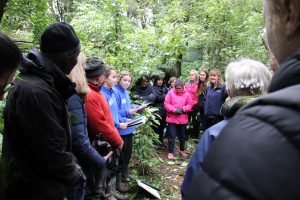
Kimbolton students guide teachers around Kimbolton Bush during an Enviroschools regional event.
To start I did a course for schools with the Taranaki Regional Council. From there I introduced worm farming, recycling and reusing and always, always included topics such as endangered animals and paper making in my teaching.
On arrival at Kimbolton I asked where to put my food scraps and the surprised office administrator said in the bin with everything else. Later he told me there was an old worm bin somewhere!! At that stage everything was thrown in together and taken across the road to the incinerator which the cleaner lit after school. The smell was often awful and I knew there was a better way. I started talking to the staff about behaving in a more environmentally friendly way. It turned out one staff member had a background in teaching conservation overseas. She was very excited and had several of her own ideas including using the Kimbolton Bush Reserve as an outdoor classroom. Another teacher had a background in forestry (also overseas) and was interested, another wasn’t that keen to start with but over time became more positive.
At that stage this ex-conservation teacher, Anwyl Minnaar, was working at the school part-time. I put to the BOT that we develop an enrichment programme with an environmental focus to extend students who were more academically challenged. Initially they said no. Come back to us with another idea – every child can be extended. I then took back a revised plan that included all Year 5-8 students and was told I could trial it for one term as there was cost involved to the BOT for teacher hours. I immediately increased Anwyl’s hours and we introduced the programme one day a week. After that one term I was told we could have another term, and then another term. The programme was so successful it was decided it would be a permanent part of education at Kimbolton, and it has been ever since.
In the first instance I used a ‘four stage for change plan’ with the staff and then asked the BOT and parent group for their ideas. We ended up with a good list! Early on in our journey the rural advisor (the days when we had advisors to schools!!) introduced me to Keith Beautrais who was a newly appointed environmental adviser to schools. It was Keith who introduced us to Enviroschools when he saw what we were already doing. He came and spoke at a BOT meeting on two occasions and we were away on our Enviroschools journey. Keith and I worked with groups of students and we had an even bigger list of ideas!
What do you remember of the school grounds at the time?
Litter!! Children ate outside and just dropped their wrappers/food scraps wherever they were!! We moved to eating inside and no more litter.
There was nothing in the playground that children had created or took responsibility for and there was no colour. It was a fairly boring playground. When asked, the children had their ideas on how we could improve it!
What about the learning programmes? How was education for sustainability taught at the time?
My recollection is that when I first arrived at Kimbolton there was no education for sustainability. To start with Anwyl and I both taught conservation and others joined in, to some degree. Anwyl set out to learn as much as she could and to network far and wide to get support and ideas for our programme. She involved the community, outside experts and even politicians!

Kimbolton School landscape encourages biodiversity.
What do you see around you now?
Recycling bins, growing units, worm bins, vegetable gardens, fruit trees, student designed and made playground features such as our large concrete tuatara and the sound ‘garden’, bug hotels, native trees, compost bins, enviro themed children’s artworks, food scrap bins, welcoming features created by students at the front entrance, herb garden, tukutuku panels, forest themed mural on shed wall and very little litter.
What is your role in the Enviroschools programme in your school?
My major role now is one of support. Support for the fantastic enrichment teacher, Heidi Morton, who replaced Anwyl when she moved to educating outside of primary schools.
Modelling the values, we have around reusing, reducing and recycling.
Doing some work in the vegetable gardens and with the worms. Attending weeding sessions. Keep NZ beautiful days. Involvement in Enviro days/afternoons.
What has been frustrating over the years?
Getting new staff on board hasn’t always been entirely successful as has keeping longer standing staff members involved. Over the years some staff have seen environmental education as something the enrichment teacher does!
I think the introduction of National Standards was unhelpful as classroom teachers became far more focused on literacy and numeracy to the detriment of other areas. Fortunately, with the passing of National Standards teachers are expanding their programmes and beginning to include aspects of environmental education once again.
Sometimes the amount of time and work needed to achieve our goals has been a challenge.
What has been uplifting?
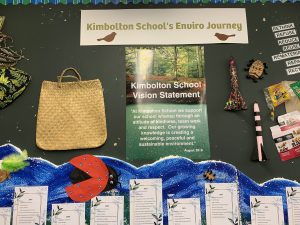
Kimbolton School’s Enviro Journey and vision statement.
The pride, positive attitudes, enthusiasm and enjoyment shown by our students and the leadership shown by our senior students. Seeing some students going from being afraid of the bush at the Kimbolton Scenic Bush Reserve to being really comfortable and seeing the knowledge the children have gained and the work they have done.
The amazing enrichment teachers we have had. Their willingness to try new things, their passion and dedication. I have loved seeing the confidence and knowledge of these teachers grow so very much. Seeing both the teachers, Anwyl and Heidi taking on other roles in environmental education has been fantastic. I feel so proud of both of them.
The fantastic support of every Board of Trustees since the programme started. The support of the community, Horizons Regional Council, Department of Conservation and Manawatu District Council and our amazing Enviroschools facilitators.
Exploring insights:
When you look back, what are some significant events or moments?
Oh my gosh! So, so many!!
Student involvement and pride in what they do has been huge.
Seeing non-academic more practical students positively shine and the self-confidence they gain
Most recently:
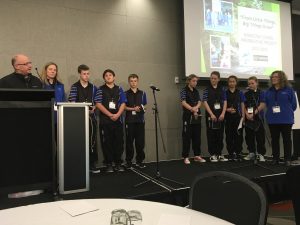
Kimbolton students presenting at the National Biodiversity Conference (NETS).
The five-year Weedbusting project working alongside Horizons (Neil Gallagher and others) at the Kimbolton Scenic Bush Reserve. They used the Formak Monitoring System and students learnt a lot about carrying out a scientific project. Then the students spoke at the National Biodiversity Conference (NETS) in 2017 about the project.
Student involvement with Gavin Scott sourcing seed and growing natives as part of the Fonterra Riparian Planting Project
Older and not necessarily in order:
- In 2005 we achieved our Silver Enviroschools award
- Our Green Gold reflections in 2009 and 2015.
- Weedbusters awards 2006, 2008, 2014
- Highly commended in the Ministry of the Environments Green Ribbon Award in 2005
- A student being selected to attend a United Nations World Children’s Summit in Japan in 2005 – a Sir Peter Blake initiative
- A display at Te Manawa starting in 2011 and lasting several years
- Seeing the growing units being well used
- The opening of our Green House celebration
- The support we received from politicians over the years e.g. David Benson-Pope, Chris Carter, Nick Smith, Simon Power
- Students taking other students and adults on bush tours
- The night bush tours
- The success of our Future Problem-Solving team at Michigan State University in 2009 –Winners of their section (The environment of our small Kimbolton Library)
- The day held to celebrate the work children did to improve the environment of the Kimbolton Library
- Our successful application to the Sustainable Management fund to rid the Kimbolton Scenic Bush Reserve of invasive trees such as blue gum, cherry and sycamore and replant with natives. This became a huge community project! And was followed by a community celebration / planting day
- Growing and planting pingao with DoC at Turakina, Foxton and Himatangi for several years
- Students from Kimbolton School featuring on the Horizon’s Green Rig (Mobile Enviro Education Classroom)
- Kimbolton Children featured in books/magazines including Living with Natives by Ian Spellerberg and Michele Frey and the Gardening magazine
- Successful application for Genesis solar panels
- Children cooking using vegetables they have grown
- Children making products using herbs from the herb garden
- 2007 2nd Holyoake Trees for Survival Award
- Transpower Neighbourhood Engineers Highly Commended Award 2014 for the sound garden
- YHA Young Conservationist Award 2005– Highly Commended for creation of the bird garden
- YHA Young Conservationist Award 2007 – Winner Contribution to conservation
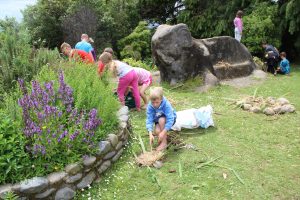
Living Landscapes at Kimbolton that foster a greater understanding of inter-relatedness and a concern for the place.
What/who provided motivation/ perseverance?
Having excellent, passionate enrichment teachers. (I almost had to beg Heidi to be Anwyl’s replacement. I just knew she would be awesome as well. And she is!!) The support of the Enviroschools facilitators, and students themselves. Support from DOC, Horizons and MDC
What were the biggest blocks?
We still don’t have enough time and the resources to do everything!!!!
What were your greatest enablers?
- A supportive BOT who saw and understood our vision and having BOT’s who have continued to see the benefits for children to work on real life meaningful projects
- Having amazing, passionate, creative enrichment teachers
- Having awesome students who are willing to learn in a practical way
- Having awesome Enviroschools facilitators
- Having the support of Department of Conservation
- Having support of Horizons Regional Council
- Having support of the Manawatu District Council

Linda guides the student through a creative activity making bird feeders on an Enviro-action day.
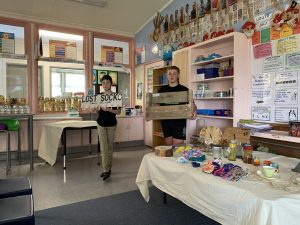
Students show off their enterprising creativity.
What is your most enduring methodology/approach that has influenced the school’s Enviroschools journey?
Listening to the students’ ideas, honouring these and involving them in all aspects of learning and planning and action.
Having the right staff, and a supportive BOT and community makes a huge difference.
One thing we do is have one day a week for enrichment/ enviro activities which helps students stay engaged.
Taking Action/ inspiring others action:
What would you tell a principal embarking on an Enviroschools journey?
DO IT!! This is important for the future. It is a fantastic way to empower young people. A fantastic way to involve the BOT, the community and other groups. Tell people what you are doing, including your local paper. Talk to other schools already involved and learn about their journey.
Think about staffing. There has to be a driver so a teacher who is passionate and inspires others is important. Make sure they have the time to do the job well.
What would be your Top Tips to empower and sustain principals?
Care about our environment and be passionate about it.
Involve all students to some degree not just a small group.
Involve the wider community.
Employ the right people.
Listen to and act on other people’s ideas and strengths, including those of your students.

Students and staff welcome visitors for their Green Gold sharing and decision-making day.
2020 Green-Gold Review
To celebrate a whole school approach and Linda’s 17 years at the helm, the school held their Green-Gold (GG) review in term 4 2020. The year 8 students talked about the history of school and what we were going to see on the day. Here is some of the key highlights since their last GG review in 2015:
- Re-vamping their school entrance – students wanted it to be more attractive to visitors. Kimbolton is quite high up (450m) and can have some harsh weather so students researched plants suitable for the climate but also provided the colour.
- Fonterra eco-sourcing and riparian planting project, working with Gavin Scott to learn how to eco-source seeds and seedlings to grow on. The school have committed to growing 1000 natives in two years to plant on Fonterra farms in the Upper Ōroua River Catchment for which they are a part of.
- The school have been learning about the uses of herbs through working with one of the parents who is an avid gardener and into permaculture. She comes in regularly and supports students with their learning and working the gardens growing veges and creating balms from plants such as kawakawa
- Sustainable enterprise project – each of the three classes talked about some mahi that they have been working on. One of the most innovative was the Senior class who presented their sustainable enterprise project. They were tasked to either work individually or in groups to come up with an idea of something they could make from reusable or re-purposed materials to sell at the local Cross Hills Country Fair. Products included clocks made from old pallets (I brought one of these), games, bird feeders from cups and saucers, candles made from melting down old bits of Crayons and scrunchie hair ties from leftover material in the craft cupboard.
- The school has excellent waste reduction systems but as a rural area they have a strong farming community. Students spoke with parents and grandparents about what they do with the waste on their farms, researched solutions to this problem and then presented their research on plastic, toxic chemicals and metal waste in rural environments, and what changes that they believe will help reduce waste and encourage more recycling to Manawatū District Council. The council were really impressed and are keen to talk more with the school next year about their ideas.
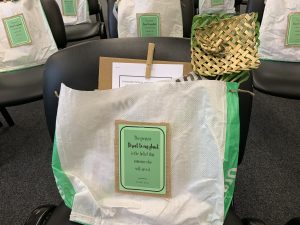
Students repurposed the fabric from fertiliser and stock food bags to be used again.
Some of their next steps included continuing their work at Kimbolton Reserve by holding a BioBlitz, get chickens, explore atua in the outdoor landscape, and provide more signage in Te Reo Māori.
Kimbolton School has benefited from Linda’s passion and conviction and we hope that by sharing her story, other leaders will be inspired. For now, Linda is starting to relax and create her personal vision and next steps after guiding her staff and students through a challenging 2020.
